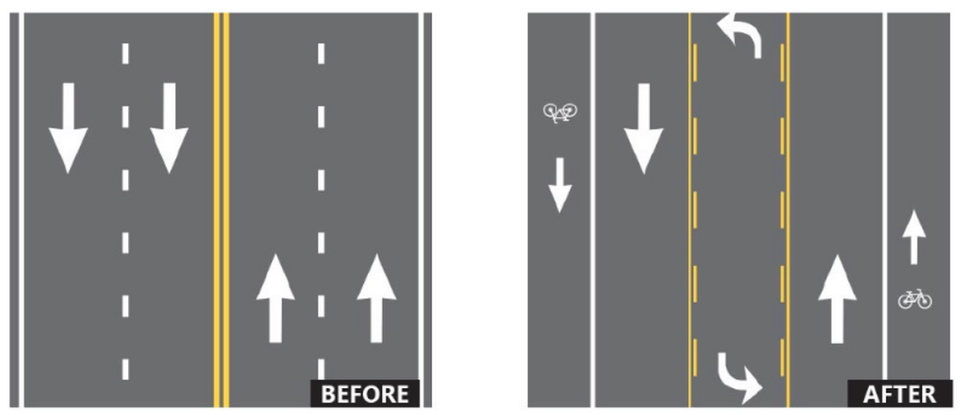Beaufort won’t support Boundary St. lane reduction without more traffic data to back it up
Beaufort County will conduct more traffic analysis before continuing with a controversial plan to cut the number of lanes on a busy stretch of Boundary Street in Beaufort from four to two. The lane-reduction plan, which would affect thousands of drivers and several neighborhoods in the heart of the city, prompted demands for more traffic information from Beaufort officials when the county unveiled it last month and asked for the city’s support.
Brittanee Bishop, a program and finance manager in Beaufort County’s Engineering Department, told the Beaufort Gazette and Island Packet Wednesday that Stantec Consulting Services will study Boundary Street traffic in the coming months. Beaufort County will then bring back a report to the city “that will either support or reject the idea of a road diet,” Bishop said.
A road diet is reducing the number of lanes to calm traffic while using the extra space for other features. On a six-month trial basis, Beaufort County is proposing to re-stripe a four-lane stretch of Boundary from Ribaut Road to Bellamy Curve into two 12-foot-wide lanes with a 15-foot center turn lane. That area is often referred to as “baby Boundary” because it is less developed than Boundary Street west of its intersection with Ribaut.
The aim of the work is to measure whether the lane reduction would “calm” traffic and reduce accidents and make Ribaut safer for pedestrians including students at USC Beaufort. If those measures do not work, the county says, Boundary could be returned to four lanes.
The idea got a chilly reception from City Council members and members of the public when it was first presented Jan. 23. They worried it would back up traffic on one of the city’s busiest roads or divert vehicles onto narrow neighborhood streets. The county, which was seeking the city’s support, didn’t get it that evening with council members arguing, in effect, that the cart was being put before the horse. Prior to implementing the interim road diet, Stantec Consulting Services told Beaufort County that it would be gathering data and observing traffic operations in advance of the proposed lane reduction. But that preliminary work had not been conducted at the time of the county’s presentation to the city.
During the upcoming corridor study, the county’s Bishop said Wednesday, data on crashes, average daily traffic and future projections will be collected as part of an overall traffic analysis.
She anticipates presenting the information at City Council work session in April.
A vote isn’t required but Beaufort County says it will not move ahead with the pilot project without the city’s support, a position that Bishop reiterated Wednesday.
“If I had to vote on it,” Mayor Phil Cromer told the Beaufort Gazette and Island Packet last week, “I would probably say no.”
But he added: “We need more information to make an informed decision.”
To Cromer, the $49,000 that Beaufort County is proposing to spend on the project is too much for a pilot project.
Councilman Mike McFee also said he couldn’t support it without more design details. Reducing the lanes on Boundary, he fears, will lead to a bottleneck. He’s been hearing from residents about the project, he said.
“They would have to provide a lot more information for me to consider that direction, given the amount of people who spoke against it,” McFee says.
Councilman Neil Lipsitz says he doesn’t like what he has heard about the project so far. Reducing the lanes, he believes, will lead to congestion and more traffic on the neighborhood roads like Congress. He also thinks it may be a prelude to a traffic circle at Ribaut Road and Boundary street, which some residents oppose.
“As it was presented to us, I don’t support it, but I would like to hear a little more from the county before I make a decision,” Lipsitz said.
Councilman Mitch Mitchell said he found the county’s initial presentation informative and understands why the county is considering it. The pilot project would give the city the flexibility to return Boundary to its current state, he noted. But he, too needs more information before making a decision.
“For now,” Mitchell said, “I’ll just hold tight.”

Councilman Josh Scallate said he opposes the baby Boundary project as it stands now. The county, he said, did not provide enough supporting evidence to justify the expense last month. “In my opinion, the data should drive the decision,” Scallate said. “In this case, the study to determine the need was to follow the commitment.”
Almost every Beaufort resident who has reached out to him opposes the road diet and would prefer that Boundary be left as is — either that or the county should investigate a better way to provide a safe commute, Scallate added.
Beaufort County also says the Boundary Street pilot project is important because traffic flows along that stretch may have an impact on the final design of the $61.7 million Reimagine Ribaut Road Project, a 5.5-mile project to overhaul of Ribaut from Boundary Street in Beaufort to the Bell Bridge in Port Royal. One of the original provisions of the work — reducing the lanes on Ribaut between Duke and Reynolds streets — was strongly opposed by by Beaufort residents. And concerns over Ribaut Road proposal may be contributing to the concerns now being expressed by residents about the Boundary Street “road diet,” council members say.

